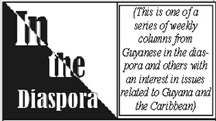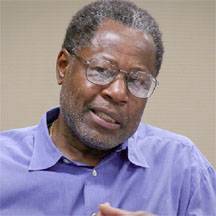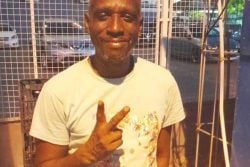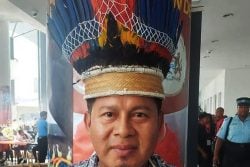By Ewart Thomas
(Professor of Psychology and former Dean of Humanities and Sciences at Stanford University, California, USA, Thomas teaches a large introductory Statistics course and graduate-level Statistics and research methods courses.)
(Excerpts from a presentation at Berbice High School, New Amsterdam, Guyana; August 5, 2013)
Brief Personal History
I would like to start by acknowledging my own educational roots in Berbice, and a few of the people, institutions and events that played crucial roles in my development.
 My parents, Arthur and Elaine Thomas, created a happy home in Vryheid in which there was the discipline of Saturday lessons in Arithmetic and Grammar; a strict insistence on fair play and respect for my six sisters and everybody else in the village, because my father didn’t want me to become an “educated rascal”; and the responsibility, from age 7 or 8, to ride into New Amsterdam to pay bills – $6.36 at Wrefords, $10.17 at Mr. Chapman, $3.33 at Davson’s, etc. – and then to return home with exact change!
My parents, Arthur and Elaine Thomas, created a happy home in Vryheid in which there was the discipline of Saturday lessons in Arithmetic and Grammar; a strict insistence on fair play and respect for my six sisters and everybody else in the village, because my father didn’t want me to become an “educated rascal”; and the responsibility, from age 7 or 8, to ride into New Amsterdam to pay bills – $6.36 at Wrefords, $10.17 at Mr. Chapman, $3.33 at Davson’s, etc. – and then to return home with exact change!
My father was Headmaster at Mission Chapel Congregational School in N/A. Possibly for this reason, I always had the feeling that the teachers all thought I was special – teachers like Ms. Nightingale (now Mrs. Trim) and Mr. Semple (these two now with an average age of 90!), Mrs. Fields-Tucker, Ms. Austin (known as the best Infant Teacher in Guyana!), Ms. Peters, Ms. Stuart, Messrs. Dolphin and James, and others.
When I was 9, I took the Scholarship Exam under my father’s instruction and failed. He was part of a group of Black Headmasters who met occasionally, and one of their basic principles was that nobody should teach his own son for Scholarship. So, when I failed in 1952, they descended on Vryheid telling my father, “You see now why you shouldn’t teach your son?” At this meeting, I.T. Henry, the Headmaster of Belladrum School, told my father, “You prepared my son, Hewley, for Scholarship, and now it’s my turn to teach your son.” So that is how I took Scholarship under Mr. Henry at Belladrum and passed it the next year!
As it happened, another son from that group of Headmasters, James A. Patterson, knew of a home in Georgetown that might have room for me to board and lodge, and advised my father to take me there to enquire. Mr. and Mrs. R.A. Gibbons didn’t really have room for me, but Mrs. Gibbons (known to all as “Dear Aunt”) mused that it would be good to have a little boy to run errands for them. To that my father immediately responded, “The boy can pay bills!” Dear Aunt smiled, made room for my cot and me, and then presided over a loving, supportive home for me for the next 7 years.
At Queen’s College, we were exposed to the breadth of disciplines – Art, Music, Woodwork (today’s Machine Shop), Sports, as well as the classical disciplines and the sciences. And we had a Maths teacher, N.E. Cameron, who used to tell us that you had to have a literary flair when doing maths! He meant that math symbols stood for words or phrases and that, therefore, a mathematical proof needed to read like proper, logical English. Precepts like these helped me through UWI and Cambridge.
In between Cambridge and coming to the USA, I did a postdoc at University College London. One afternoon in early 1969, I was walking down Tottenham Court Road when the thought came to me, unbidden, that I really needed to be in the USA. The research papers that I was reading had addresses like Stanford, CA, Ann Arbor, MI, and Philadelphia, PA; and I felt I needed to be there, rather than in London. Also there was only one Black Professor that I knew of in all of English academic history – and that was Sir Arthur Lewis, who had the Jevons chair at Manchester and won the Nobel in Economics in 1979. So I figured that my chances of advancement would be very much better in the USA. That was just a thought; I did not act on it at the time.

However, a few weeks later, my advisor, Professor R.J. Audley, was invited to a conference in Ann Arbor. He couldn’t go but he told them that I would be an appropriate replacement for him. This was a stroke of good luck for which I was well prepared after that afternoon on Tottenham Court Rd. I went to the conference, there was a job offer from Ann Arbor, and I accepted it – and I even met my wife, Odette, there!
As a last example, years later, I was Dean of the School of Humanities and Sciences at Stanford during its Centennial Campaign, when we received a donation to honor our best Teaching Assistants. It is usual to name the honor after the donor, or someone whom the donor wants to memorialise. But I remembered that in 1953 there was a broadening of access to Queen’s College and Bishops’ High School among less privileged boys and girls by the granting of what were called “Coronation Scholarships” – in honor of Queen Elizabeth II’s coronation. So I decided to call the Stanford awards, “Centennial Awards”, to celebrate the historical moment rather than the donor.
These simple slices of personal history do not prove much. However, when I look at the full arc of events, many of which were serendipitous, I believe that my teachers gave me a palette of skills that have allowed me to adapt to situations that could not have been foreseen when I was acquiring those skills. In other words, much of who I am today I owe to my teachers, and I am very grateful for their nurturing!
The Importance of Teachers
The emphasis on teachers is not new. Professor Belle Tyndall, who was an influential figure in Guyanese educational circles before joining the faculty of George Washington University, referred me to a venerable text, the Handbook of Suggestions, put out by the United Kingdom Board of Education in 1944. It urged teachers and others to make Education more relevant in a world in which distances have shrunk and “the people of today are nearer to each other and their lives are more closely linked together than ever before.” This was prescribed reading for our Teachers’ exams in Guyana in the 1940’s and 1950’s – but it could’ve been written today!
Most of us, including our teachers, have been trained in a discipline, because that’s how the academy is organized. But a lot of fascinating research and innovation takes place also in interdisciplinary programs and projects, like a program on ethics, economics and public policy, or one on engineering and the environment. Similarly, we are seeing studies of young children and teenagers that compare the outcomes of teaching within disciplines versus teaching to solve a specific societal problem, like how to get clean water, or how to get preschoolers to eat more vegetables. The latter approach has to be interdisciplinary, and we are seeing that it promotes conceptual understanding, innovation, and interest in learning (and schooling) at very early ages.
We should be aware also of the likely societal consequences of incorporating technology into the curriculum – what they are and how much we value them. For example, we should not be surprised that it will likely widen the gap between the best and worst schools. As a society, we can probably tolerate some gap, but only if the worst schools are also reaping the benefits of the new policies.
These are not settled issues, but through sustained discussion and cooperation among all actors – students, teachers, the Ministry of Education, those responsible for curriculum development, and so on – a shared vision of where we ought to go should emerge.
Vision for our society
A perusal of articles in the Kaieteur News (this is my most reliable source of news about Guyana!) suggests some important elements of this vision. For example,
Professor Daizal Samad of the UG campus at Tain emphasizes inclusive education in his vision; and one might add the related principles of equal opportunity, equity and fairness. Another set of ideas concerns the breadth of our education, e.g., the emphasis on problem-oriented learning, and the mix of ‘soft’ and ‘hard’ skills. Mr. C.O. Perry argues that the study of Guyanese reality in greater depth would lead to “the emergence of various forms of leadership, meaningful civic actions and social developments, … volunteerism and service that contribute to school and community development.” In other words, there is a tradition of educational excellence in Guyana that should not be ignored as we incorporate new technologies.
Technology and Schools:
Two Examples
The various projects and proposals that fall under the broad rubric of Technology and Schools can be more or less complex. At the least complicated end, there are courses that are ripe for improvement with very little change in the existing curriculum, and with the application of free online resources, so that the teacher could simply download the apps and point students to them. A good example is the Khan Academy: “With a library of over 4,300 videos on everything from arithmetic to physics, finance, and history and hundreds of skills to practice, we’re on a mission to help you learn what you want, when you want, at your own pace.” There is some controversy in the high schools near me, but it’s spreading quickly.
Perhaps the most ambitious and challenging project is that of achieving the Caricom goal of “embracing technology and digital literacy in all spheres.” In the opinion of Andrew Rudder, a Lecturer in Computer Science at the University of the West Indies, St. Augustine, we ought to be teaching computer programming to children as early as 6-years old. He feels that the new generation of “object-oriented” programming languages are suitable for 1st-graders – these are the languages that underlie various apps for the iPad. When a child learns basic programming skills (e.g., ‘if-else statements’ and ‘for loops’), he or she would be learning how to think logically, systematically, and critically. And by the age of 10, Rudder thinks, children in such a program would be ready for a language like Java.
I find this idea most exciting, and I hope that enterprising partnerships can be formed to try it out immediately. We might start with an experimental lesson plan designed by experts; a few schools, say, 10 to 20, willing to serve as guinea pigs; a few tech-savvy teenagers who can spare a couple of hours a week to tutor 1st graders; a public-private agency willing to donate 1000 iPads to the children; a committee within CXC to monitor the lesson plans and design competency tests; and a governmental commitment to support the expansion of this project to other schools as interest grows.
I am sure that many individuals in Guyana and abroad, including myself, would love to help in advancing the agenda of bringing the children of Guyana fully and confidently into the 21st century.





